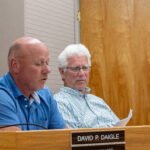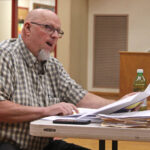HOULTON, Maine — At a special town council meeting on Monday in Houlton, the council voted, 5-1, to postpone the planting of new trees in Market Square this spring.
The postponement still falls within the Canopy Grant guidelines.
The council did not have any qualms about setting the trees or the species chosen — ivory silk lilac — however, the concern arose in the removal of the existing trees. A request for proposal will be advertised.
A Canopy Grant Committee consisting of Lori Weston, town economic/community development director; Jane Torres, Houlton Chamber of Commerce director and 15-year tree nursery manager; Traci Tweedie, NMDC consultant and avid gardener; and Dan Jacobs, district forester, Maine Forest Service, has extensively researched the planting, removing and care of the downtown trees.
When Councilor Robert Hannigan asked Weston about the removal of trees there now, she confidently responded the committee had already looked into the process with diligence. The only thing lacking in the process was final cost.
The committee has consulted with Thomas Hoerth, the city of Bath’s arborist and tree warden.
“The city of Bath has the same type of grate and what they assume is in the ground for roots,” said Weston.
As the committee continued with its proposal, councilors wondered what the whole project going to entail, and if or how much damage is possible. Hoerth figured it would be very minimal.
“It is all about the equipment we use,” Weston explained. “We would need a mini excavator with thumbs and Tom recommends an air spade, which the city of Bath is more than willing to loan to us to do this project.”
When writing a grant, Weston said, it is always being revised through the process.
“It is figuring out what is optional and what is not,” she said. “What is the best way to move with this project to have it done efficiently and cost-effectively.”
“I do not have a problem at all with this project,” said Councilor Sue Tortello. “I think it is one of the most wonderful things we have decided to do. Just reading the letters of support you have received from various businesses, shows me how strongly this is supported in the community.
“But, my concern is this, not so much with the tree species, but it is the removal of the existing trees,” she added. “We have a proposal before us tonight to approve the expenditure of 28 lilac trees that will be arriving in the spring and will need a place to go. But, we do not have the assurance whether we can remove the 28 trees they are going to replace for the projected cost that was submitted in the grant.”
The grant noted it would be $2,500 to remove existing trees.
“My quandary is this, if in fact, we find out the removal is going to be way more costly than we had anticipated, number one, where are we going to come up with the money and if we cannot remove all 28 trees, what are we going to do with almost $6,000 worth of trees that we have purchased?,” asked Tortello.
The committee does not know when the actual tree removal will be since one has not even been dug up to see if the sidewalk or piping will be disturbed.
“In the construction of the downtown,” said Councilor Wade Hanson. “Those trees were replaced inside a catch basin that retained the root wall. It does have holes in it for water drainage.”
“Do you know for sure it has not grown up,” Chairman Paul Cleary asked Hanson. “There is an electrical conduit and sewer pipes. And those roots as they spread will grab onto something.”
“You do not. You would not be able to tell,” replied Hanson.
“Until we remove one, we do not know what we are going to run into,” Cleary added.
Torres answered, “The equipment is meant to cut the roots off. You are not taking all of those roots out. You are cutting around that square [catch basin].”
The committee has built in flexibility with its proposal.
“We’ve discussed alternatives,” said Jacobs. “We haven’t even discussed any of the in-kind that could be used toward the grant.”
The Canopy Grant is $8,000 with the town required to match the funding. Cleary was surprised that when the town asked for tree bids that a request for proposal of removal wasn’t included.
“Lori and her committee did a great job and we appreciate it,” said Cleary. “The answers need to be in front of us … it doesn’t hurt to have all the vital information in front of us so we can make a sound decision. Now we are forced because it is a special meeting to vote. We only have the price of trees. You cannot complain about the committee, you guys have done a great job.”
“When we write the request for proposal, we want to do diligence as well,” added Weston. “But, we put our grant in to meet the deadline knowing full well that a lot of things are going to change by the time you are actually ready to administer the grant.”
The canopy grant is serviceable until June 2015.
“In the spirit of flexibility, would there be any harm in moving forward with the tree-removal process,” asked Tortello. “Perhaps going another summer with the existing trees? It sounds to me like everyone who has looked at them says they need to go. If we let them go one more summer and remove them in the fall, then they would be gone and we would have the holes in place.
Then, we would have first-hand knowledge of whether we could replant trees in those holes to the specs required by this grant. We would have one winter of holes in the ground and in January make the order [for trees] and plant those trees in May?”
The Canopy Grant committee had thought about this as an option, but were advised to order the trees.
“It will be a careful decision where these new trees go,” said Weston.
“We may find if we do the removal of the trees first, we do not need 28,” said Tortello.
Cleary also noted with more time, other avenues may open up to do more of a project with moving the trees and doing other things to the sidewalks downtown.
“I would rather delay everything like Sue suggested instead of ordering trees now and carrying them over for a year,” said Jacobs. “My least favorite option would to have the trees and have to hang onto them and plant them the following growing season.
“The big problem is there are so many unknowns with the removal,” added Jacobs. “Until we pull one out, there is no way around the unknowns.”
It would have been ideal to do a test on a tree last fall, but the grant was received in January. The time to plant trees is in the spring.
“The issues I see with these trees downtown is the shade,” said Ben Drew, resident and property owner. “They grow disproportionably, as they are growing in a shaded environment. I don’t know if it would make sense to have a few options of what we may put in instead of getting all one type of tree.”
The property Drew owns on the corner is shaded most of the day because of the building’s position.
“As far as the maintenance, when talking about the pruning required, is that going to happen and if it is, who is going to do it?,” he asked. “Questions that I am sure have already been discussed at great length at some point by someone on the committee.”
“As far as the orientation of Market Square, with any tree, you are going to get phototropism. They are going to grow toward the light,” said Jacobs.
Torres said the silk ivory lilac trees will be 10 to 15 feet tall and are between three and four years of age.
“Ben, the key will be a really definitive maintenance plan,” Weston added.
Cleary also asked to get a cost on annual maintenance of the trees, as well. Weston noted the Canopy Project offers another grant for planning and education and the group will be investigating that in the near future.
Weston said the committee will continue to press on and notifications of the ongoing process will be made periodically for the council and citizens.
The next council meeting is April 14 at 6 p.m.







